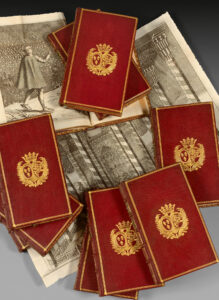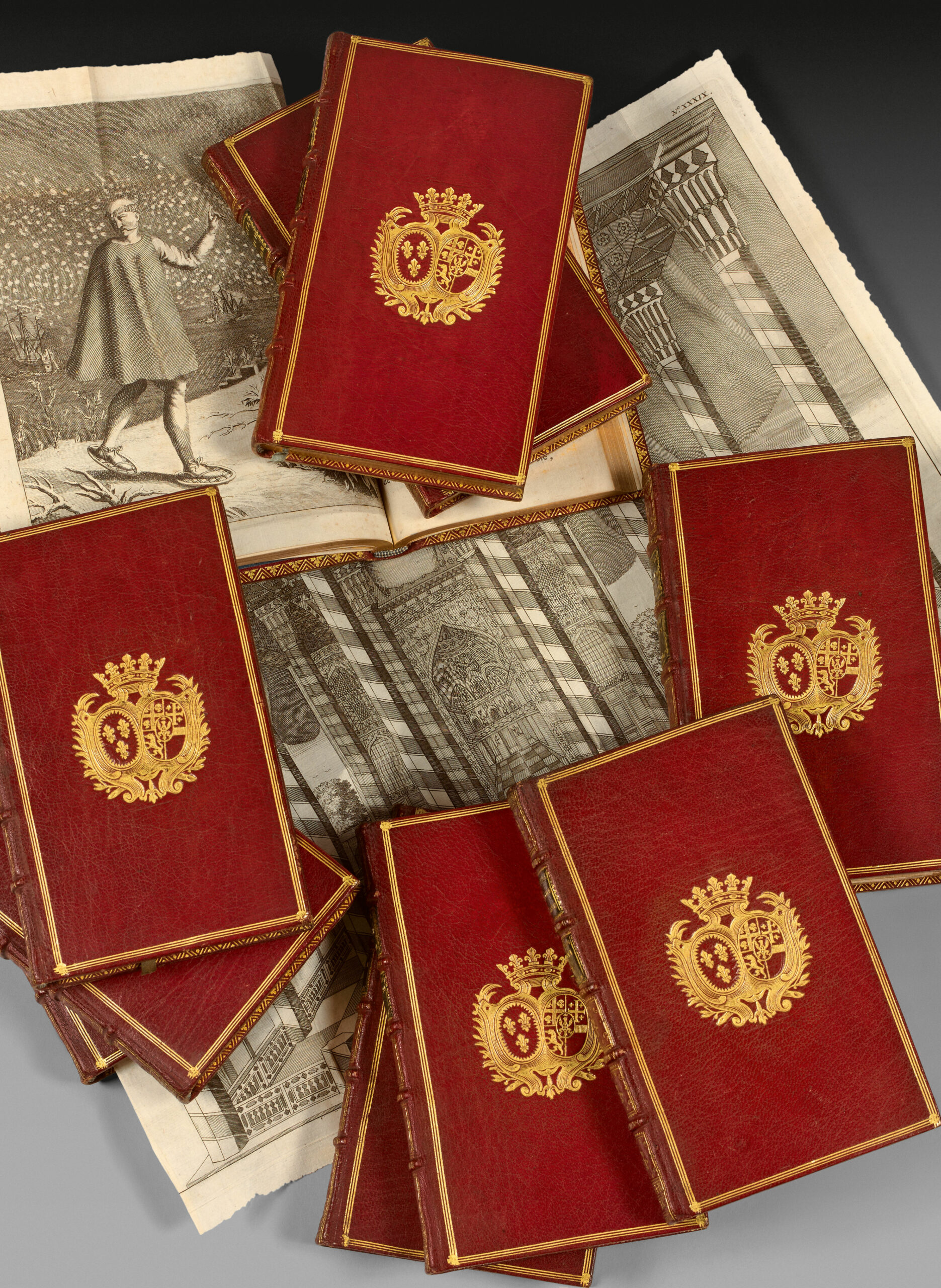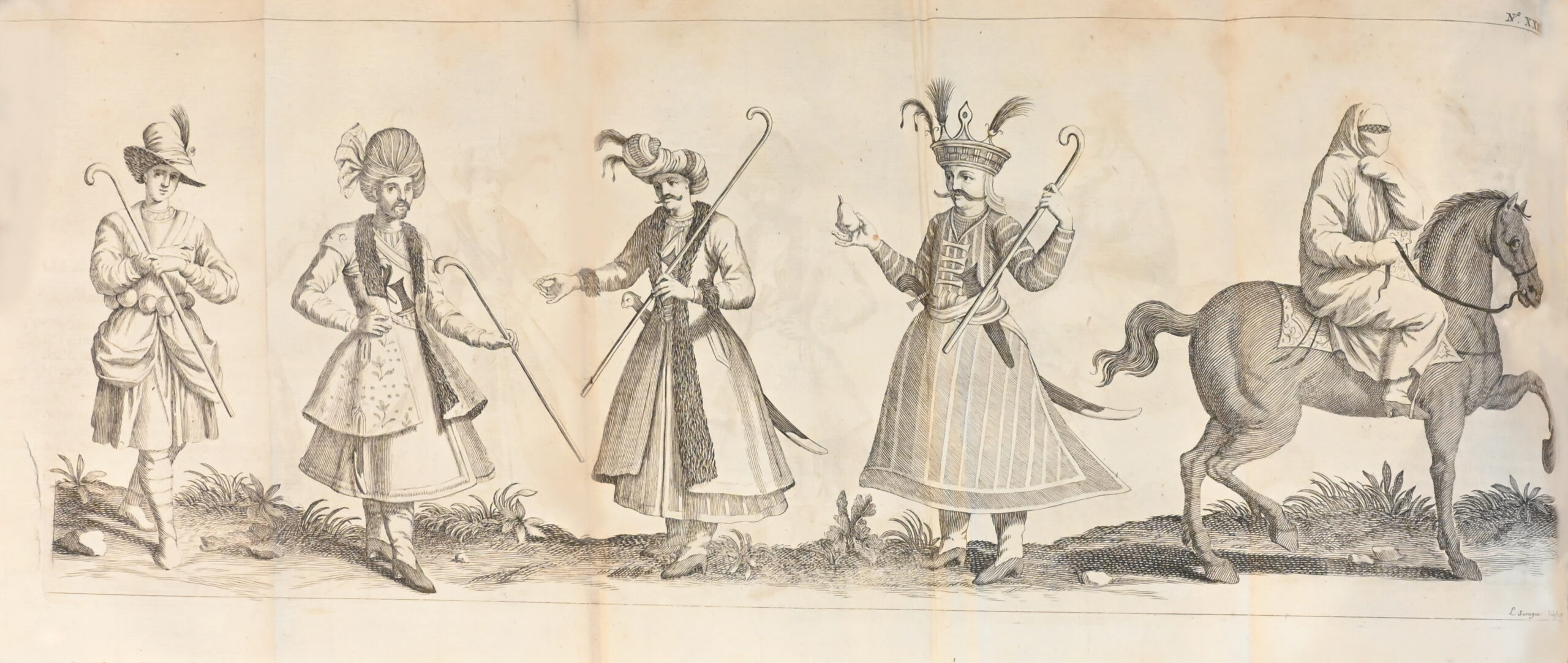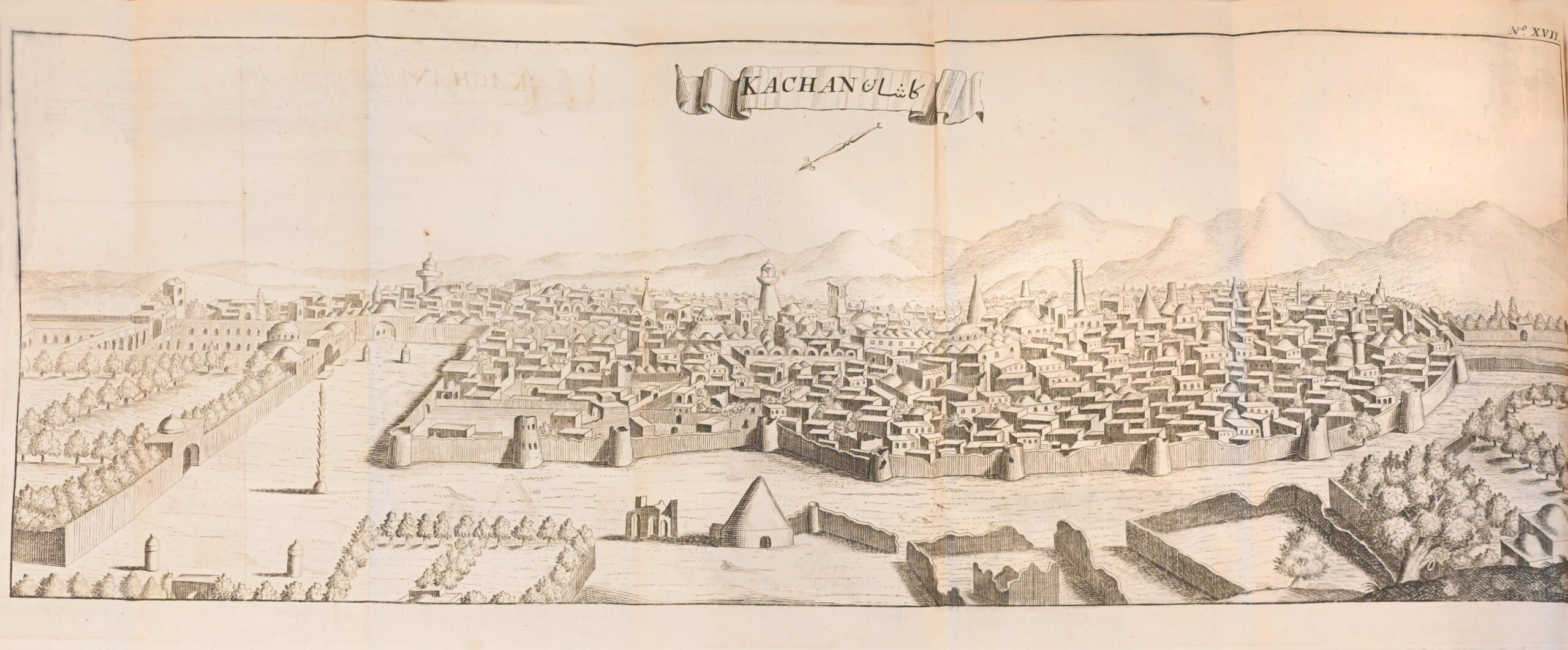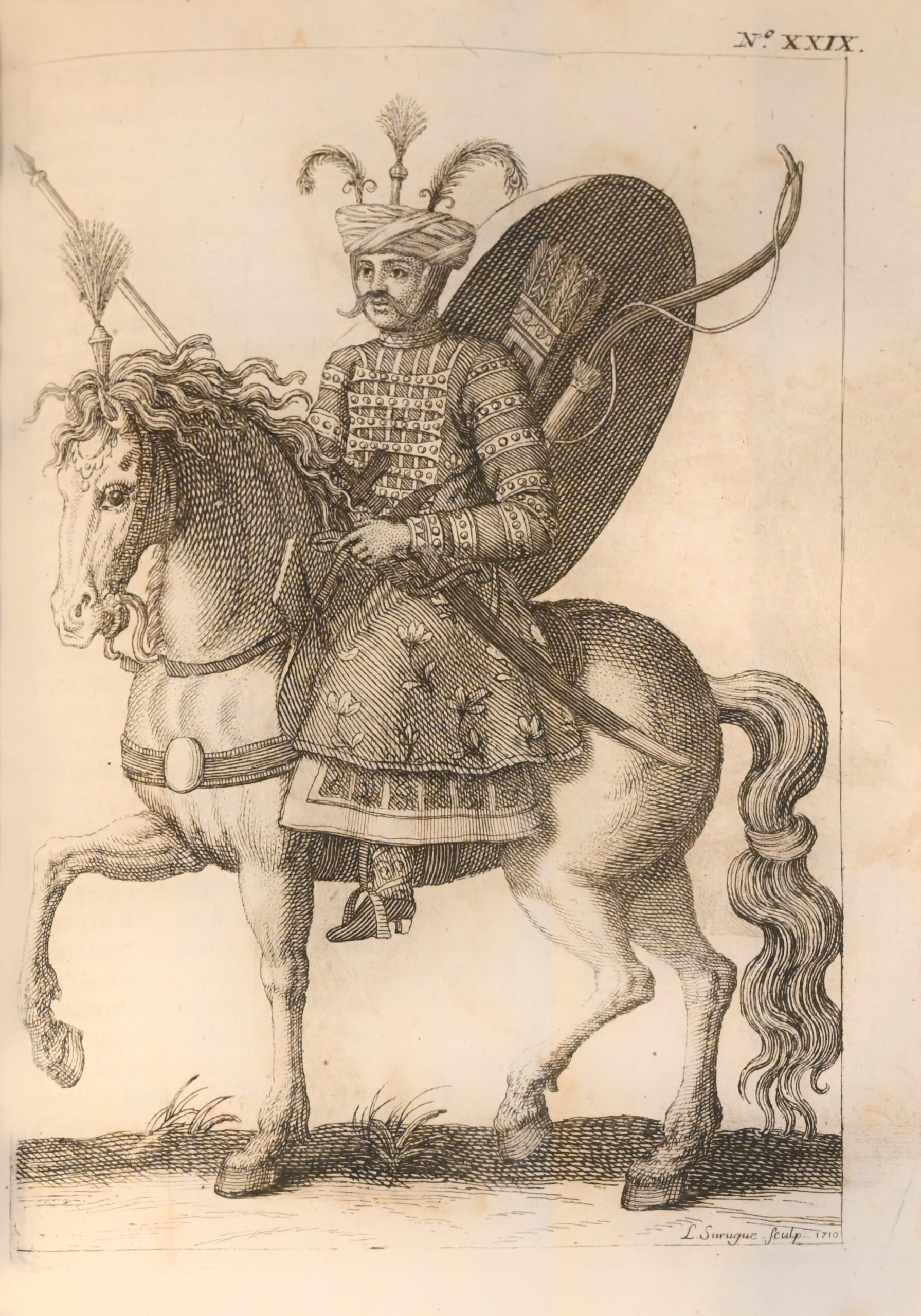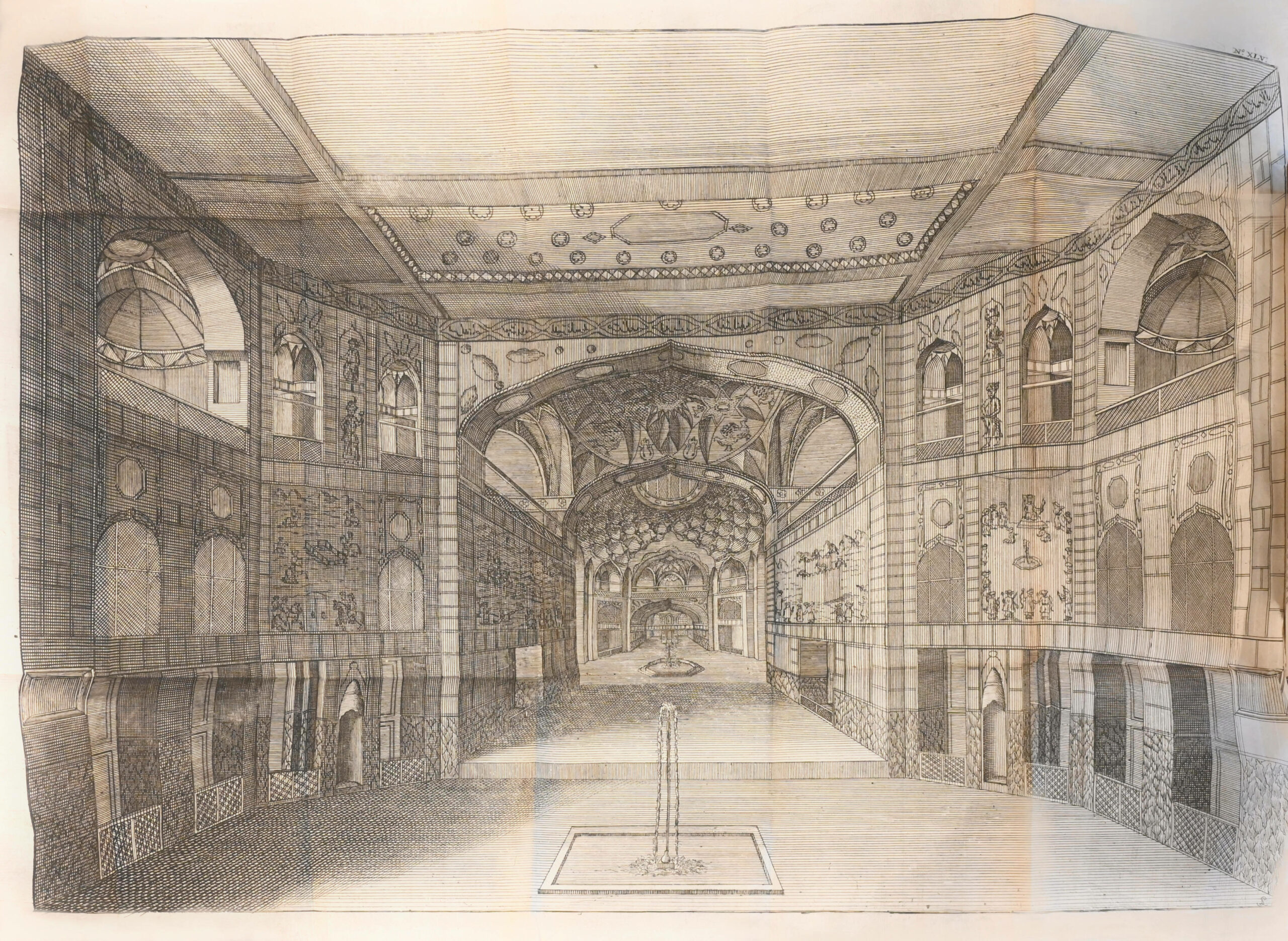Amsterdam, Jean Louis de Lorme, 1711.
10 volumes 12mo of: I/ 1 portrait of the author, (11) ll. 254 pp., 1 folding map and 1 folding plate; II/ 334 pp., 9 folding plates; III/ 285 pp., 7 folding plates; IV/ 280 pp., 6 folding plates; V/ 312 pp., 4 folding plates and 4 folding tables; VI/ 328 pp., 5 folding plates; VII/ 448 pp.; VIII/ 255 pp., 16 folding plates; IX/ 308 pp., 29 folding plates; X/ 220 pp., (41) ll. of table. Red morocco, coat of arms in the center of the covers, triple gilt fillet, gilt ribbed spines, olive green morocco lettering pieces, gilt edges. Contemporary binding.
160 x 98 mm.
First complete edition, partly original, of one of the best ancient descriptions of Persia. It is still today an invaluable source for the knowledge of Persian culture and civilization in the late seventeenth century.
A portrait, a map, 77 plates (views, costumes, ancient writings, antiquities, etc.) and 6 folding tables (volume V). Each title is adorned with an intaglio engraved vignette.
“Chardin’s Voyage en Perse is one of the most interesting voyages published in the eighteenth century.” Brunet, I, 1802.
Son of a Protestant jeweler of the Place Dauphine in Paris, Jean Chardin (1643-1713) quickly showed a pronounced taste for travel, where curiosity for other places and the hope of doing profitable business were combined. He made two long stays in the Middle East. The first one, from 1664 to 1670, saw him staying for a long time in Isfahan, and named “merchant of the shah”. On his return, he published a report of the Coronation of Soliman III (1671). His second stay in the Middle East took place from 1671 to 1677. In 1686, he published in London the journal of his second trip to Isfahan (which Bayle praised highly), and then, in 1711, a much more complete edition which includes, in addition to the same journal (volume I), a very detailed presentation of Persia (volume II), a particular description of Isfahan and the account of a trip to Hormuz (volume III).
“His official position, his relations with the main characters, the knowledge that he hastened to acquire of the idioms of the country, allowed him to collect a multitude of information on the government, the customs, the antiquities, the monuments and the history of Persia. A skilled draughtsman, whom he had brought along, accompanied him in all his explorations, and he was able to bring back exact reproductions of the monuments, costumes, ruins of Persepolis, weapons, utensils…
It has been claimed that the academician Charpentier had helped Chardin in the writing of his book. Whatever the case may be, what unquestionably belongs to the illustrious traveler are these precious materials collected with so much intelligence and courage, these deep researches, these observations, these curious and authentic information on the history, the administration, the legislation, the mores, the sciences, the arts, the customs of a country that was, so to speak, unknown until then.
“The unanimous testimony of travelers, says Langlès, who, since Chardin, have visited and described the same regions, has only served to note the accuracy, the depth of his observations, the variety of his knowledge and his veracity.
The superb illustration, engraved on copper, includes a frontispiece portrait in first issue by Thomassin dated 1710 and 78 large plates, engravings or maps, most of which are folding or on double-page, as well as 6 engraved head pieces.
Chardin was accompanied by a drawer, Grelot: all the views, scenes and portraits were done from life.
A superb copy bound in red morocco with the arms of the countess of Provence (1753-1810).
“Marie-Joséphine-Louise-Bénédicte de Savoie, second daughter of Victor-Amédée III, duke of Savoie and king of Sardinia, and of Marie-Antoinette-Ferdinande, infanta of Spain, born in Turin on September 2, 1753, married on May 14, 1771 Louis-Stanislas-Xavier, count of Provence, later Louis XVIII, of whom she had no children. She took the title of Countess of Lille in emigration and died in Hartwell, England, on November 13, 1810.”
“The Countess of Provence had, following the example of her husband, who was very interested in literature and cultivated the muses, a taste for letters and the arts. Her library, whose handwritten catalog is in the Arsenal, was composed with great intelligence, and included 1 665 volumes which were dispersed during the Revolution.”
The twin copy of this one, bound in 10 volumes in red morocco with the arms of the Countess of Artois (1756-1805) was sold for €45,000 on May 5, 2010, 13 years ago (Ref. Rare Books, #21).
“Animated by a liberal spirit, Louise de Savoie, Countess of Provence, had her hour of popular favor, by defending at the beginning of the Revolution, what she herself called, then, the rights of the nation, and the noise of the rather lively explanations she had, on this subject, with Queen Marie-Antoinette, earned her more than once the applause of the crowd” (Quentin Bauchart, II, p. 313-314).
This princess, who owned a library in Versailles but also in her country residence in Montreuil, shared with her husband a taste for letters and arts.
